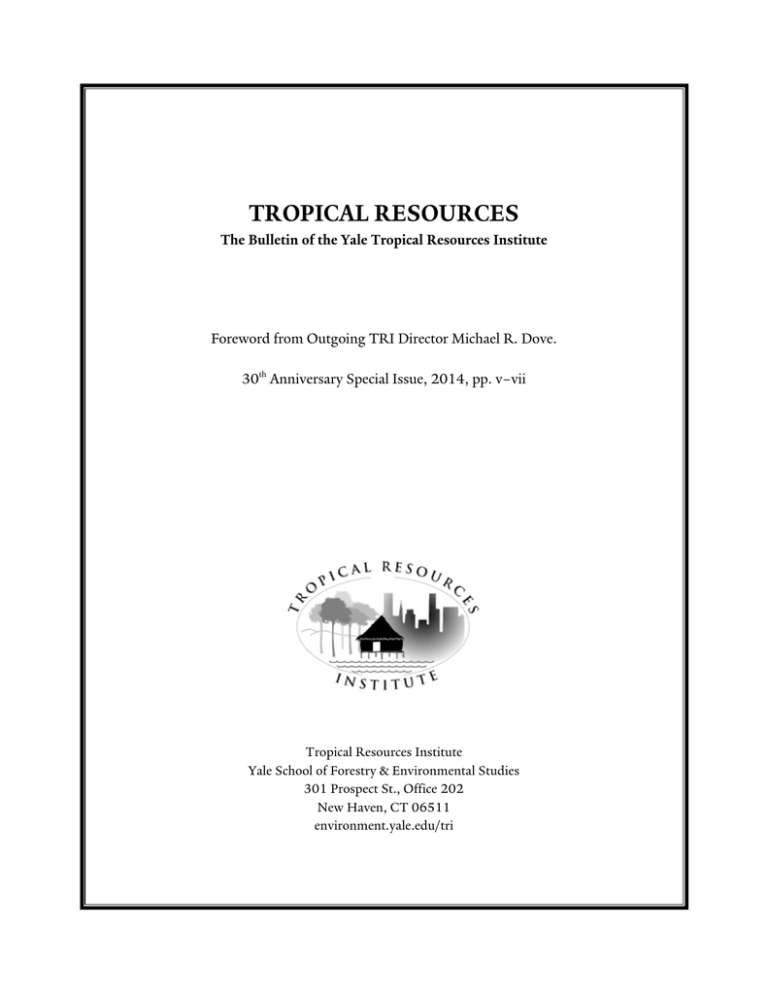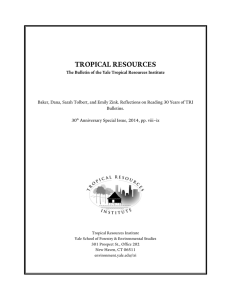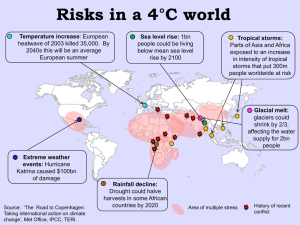Document 11492828
advertisement

TROPICAL RESOURCES The Bulletin of the Yale Tropical Resources Institute Foreword from Outgoing TRI Director Michael R. Dove. 30th Anniversary Special Issue, 2014, pp. v–vii Tropical Resources Institute Yale School of Forestry & Environmental Studies 301 Prospect St., Office 202 New Haven, CT 06511 environment.yale.edu/tri Foreword to the Anniversary Edition Outgoing TRI Director, Michael R. Dove This special issue of the Bulletin of the Tropical Resources Institute commemorates the 30th anniversary of the founding of TRI. It offers an apt moment to reflect on three decades of support by TRI of research in the tropics by F&ES students. These have been enormously important decades for tropical peoples and environments. Over the course of these three decades, human degradation and conservation of the tropics both became prominent topics in global science and the popular imagination. This period saw the rise of tropical deforestation and biodiversity loss as major global environmental discourses. Anxiety was fed by the first great conflagrations striking the forests of Sumatra and Kalimantan and enveloping the entire Southeast Asian region in smoke. During this time the global community saw for the first time differentiation within tropical countries as locals battled fellow nationals for control of their own lands and resources, as in the famous Penan blockades of logging roads in Malaysian Sarawak, and in the rise of the rubber tappers’ movement in the Amazon, whose charismatic leader Chico Mendes was assassinated in 1988. Such movements led to the development of completely novel global linkages, which involved non-tropical peoples in tropical affairs in new ways, as in visits of political support by the rock musician Sting to the Kayapo in the Brazilian Amazon. This period saw the development of completely novel economic and policy mechanisms to try to help conserve tropical forests — such as timber boycotts and certification — and at the same time assist communities Thirtieth Anniversary Special Issue living in these forests — by means of extractive reserves, the marketing of rainforest products, and collaboration with native peoples to identify plants with medicinal properties. In short, these were three decades with profound consequences for the peoples and environments of the global tropics, and the conservation and development science and policy devoted to them. During this period TRI came into being and grew into its current status as the most important source of funding at Yale for student field studies in the tropics. We might say, indeed, that over these three decades, TRI, the tropics, science, and policy all co-evolved — as also suggested by Emeritus Professor William Burch Jr., the first Director of TRI, in his own wonderful, lyrical essay in the pages to follow. A review of the authors reporting on their research in the TRI Bulletin over this three-decade period reads like a ‘Who’s Who’ of tropical studies. Many of today’s leaders in academic and policy circles were early contributors to the Bulletin, including several current Yale faculty. The topics studied evolved over the years, in keeping with trends in the academic and policy worlds (as discussed in the following article “Reflections on Reading 30 Years of TRI Bulletins”, by the TRI Program Assistants Dana Baker, Sarah Tolbert, and Emily Zink). But they all have one thing in common, which perhaps reflects the mission of TRI’s home institution, the Yale School of Forestry and Environmental Studies. F&ES occupies an unusual niche in North American academia, in Tropical Resources Bulletin v Michael R. Dove (2014) purposively linking both natural science and social science, and theoretical study and application or practice. Just as F&ES is dedicated as an institution to crossing these sacrosanct academic boundaries, so too do we see in these articles an analogous effort to cross boundaries or borders. The fundamental dynamic of the research in all of these studies from the Bulletin is based on crossing lines, on linking things that are not usually linked —places, disciplines, topics, methods, observer and observed, nature and culture — and in all cases this becomes a source of special insight. Thus, in the 1980s we have both Ramachandra Guha and Mark Ashton crossing geographic borders, drawing unusual comparisons between South Asia (India and Sri Lanka, respectively) and North America. Crossing disciplinary borders, we have a pioneering study of urban political ecology in Kathmandu, Nepal by Anne Rademacher, and a study of lemurs in Madagascar by Eleanor Sterling and Betsy Carlson, the former being one of the first candidates in the unique joint doctoral program between F&ES and Yale’s Anthropology Department. We also have studies of hybrid topics, which bring together in a single study subjects not typically combined, like Andrew Mathew’s study of the political intellectual history of both the forest service and forest communities in Mexico, and Janet Sturgeon’s study of the performance under Chinese governance of social forestry approaches developed under very different political regimes. Perhaps the most common boundarycrossing represented by the studies in this issue is that between different methodologies, producing hybrid methods. While nearly all of the studies reprinted here do this to some extent, there are several especially clear examples: thus, Laura Snook combines local oral history with silvicultural techniques to Thirtieth Anniversary Special Issue date and study stands of mahogany in Mexico; Richard Chávez melds the application of GIS techniques with the Universal Soil Loss Equation; and Hui Cheng brings real-world evidence and insights to bear on her laboratory modeling of a shrimp farm. Other examples involve one of the most recent additions to the list of topics studied at F&ES, which currently dominates the school in some respects, global climate change: William Collier combines approaches from anthropology and history to examine the impact of climate change on agriculture in Kenya; and Stephan Wood combines insights from economics and anthropology to examine the same topic in northern Guinea and southern Senegal. Most of the studies look at both nature and culture, but some do this systematically: Angela Quiros, Dora Nsuwa Cudjoe, and Maureen DeCoursey each examine impacts (from ecotourism, craft production, and the medicinal plant trade, respectively) on both the environment and the human community. Some of the earlier articles in the Bulletin laid the basis for extremely influential later work by the scholars involved by legitimizing the study of environments showing both natural and cultural influences — that is, ‘anthropogenic’ environments — the study of which is commonplace today but was not a generation or two ago. Thus, we have Daniel Nepstad’s study of pastures that have been cut out of the Amazonian forest and then abandoned; Miguel Pinedo-Vasquez’ study of traditional management of forests in the Peruvian Amazon; and Hugh Raffles’ study of human-made waterways in the Amazon estuary. Finally, some of the studies presented here reflect the increasingly blurred boundaries between observer and observed that F&ES students and professors alike now encounter in the field: thus, Erin Kellogg writes Tropical Resources Bulletin vi Michael R. Dove (2014) about an environmental NGO that she worked for in St. Kitts-Nevis in the Caribbean; and Doolittle discusses the varying expectations from her own work of the NGOs and local communities with whom she collaborated in Kalimantan, Indonesia. Taken as a whole, the body of work presented here shows the potential benefits of de-naturalizing the boundaries of tropical studies — asking new sorts of questions, exploring them with new sorts of methods, with new sorts of ends in mind. Thirtieth Anniversary Special Issue Tropical Resources Bulletin vii






